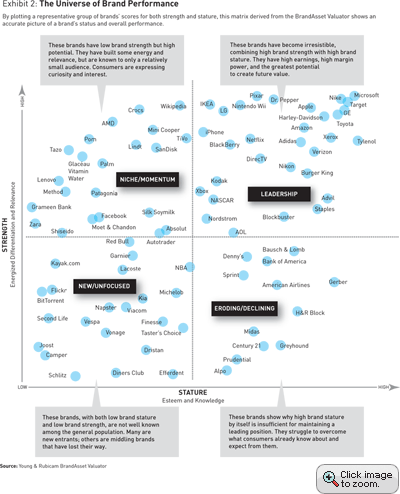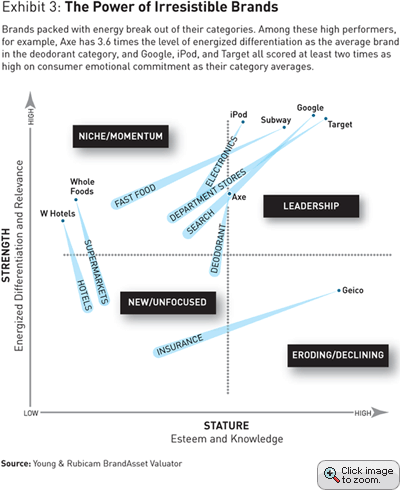The Trouble with Brands
Most consumer brands are not creating value. The exceptions share a set of “energized” attributes that companies can identify and exploit.
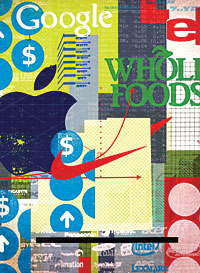 |
|
Illustration by Alex Williamson
|
Many companies that produce goods and services for consumers face a serious dilemma — quite apart from the effects of the current global economic downturn. For at least the past five years, the tried-and-true formulas to boost the sales and market shares of brands have been becoming increasingly irrelevant and have been losing traction with consumers. Globally, the aggregate value of brands to consumers has been falling steadily, and this decline began well before the recent slump in stock prices.
We know this through extensive research we have conducted on brands. Since 1993, we have been tracking the way consumers perceive and value products and services around the world to explain how brands grow, decline, and recover. Each year, we interview almost 500,000 consumers around the world, and each quarter, 15,000 consumers in the United States. We have studied 40,000 brands across 44 countries on more than 70 brand metrics, which include everything from the awareness consumers have of a brand to the particular ways it makes them feel.
Beginning in mid-2004, we discovered several curious and sobering trends in the data. Consumer attitudes about all sizes and segments of brands were in serious decline. Across the board, we saw significant drops in the key measures of brand value, such as consumer “top-of-mind” awareness, trust, regard, and admiration. This was true not just for a few brands, but for thousands, encompassing the entire range of consumer goods and services, from airlines and automobiles and beverages to insurance companies and hoteliers and retailers. We found that most brands were not adding to the intangible value of their enterprises the way they used to. Instead, the majority of brands seemed to be stalled in the consumer marketplace.
But at the same time, separate research we did on the financial performance of consumer companies revealed that brands were indeed creating more and more value for companies and shareholders. This was evident in increasing share prices, driven higher by the intangible value that the markets were implicitly attributing to brands. This pattern held as equity prices rose through 2007, but even after the recent collapse of prices, our models show that brand value continues to account for roughly a third of the total stock market value of corporations. In other words, there was — and is — a mismatch between the value that consumers saw in brands and the aggregate value that the markets were ascribing to them. This contradiction comes about because the perceptions influencing the dollar votes of consumers on Main Street are very different from the financial and mechanical analysis used by traders and analysts on Wall Street.
When all the facts were put together, we discovered that, yes, there was an increasing expansion of the value that financial markets are attributing to brands, but this value growth is actually attributable to fewer and fewer brands. Sure, for financial juggernauts like Google, Apple, and Nike, brand value continues to increase powerfully, but the number of these kinds of high-performance, value-creating brands is diminishing across the board, while the actual value created by the vast majority of brands is stagnating or falling.
This overall mismatch between consumer attitudes toward brands and the market values of the universe of companies that produce and own them is, we believe, a recipe for disaster at two levels. At the macroeconomic level, it implies that the stock prices of most consumer companies are overstated: A “brand bubble” is implied in their stock prices, and once it deflates — or worse, pops — it could further drive down valuation multiples and stock prices around the world. Meanwhile, for leaders of consumer-related corporations, the mismatch points to a serious, continuing problem in brand management.
What can consumer companies do to make sure that their brands aren’t among the losers? Our research revealed that the most successful brands today — including Adidas and iPhone and Pixar and Wikipedia — resonate with consumers in a special way: They communicate excitement, dynamism, and creativity in ways that the vast majority of brands do not. We call this quality “energized differentiation,” and we have identified, out of dozens of brand attributes in our consumer-research database, the metrics that capture this quality. By focusing on these attributes, marketers can keep their brands constantly moving and gaining value. In a world of excess capacity and diminishing trust, creating these kinds of energy-infused brands can help companies reinvigorate their brand management practices.
The Plunge in Brand Perceptions
As we set out in 2004 to compare consumers’ and Wall Street’s valuations of brands, we were acting much like meteorologists analyzing the various forces of nature to assess which combination causes hurricanes. To measure how brands affect the current and future financial performance of their enterprises, we merged our brand database with 15 years’ worth of financial data from Standard & Poor’s Compustat database and the University of Chicago’s Center for Research in Security Prices, studying a specific universe of 900 multinational “mono-brands.” These companies stake their entire name on a single powerful brand and derive more than 80 percent of their annual revenue from that brand. They include firms such as Intel, McDonald’s, and Microsoft. Along with marketing professors Robert Jacobson (Foster School of Business, University of Washington) and Natalie Mizik (Columbia Business School), we began analyzing many consumer variables to see if we could tell which group of brand attributes came closest to explaining unanticipated changes in stock price, especially upward valuations. Our emphasis was on unanticipated stock price changes because market values already anticipate a wide range of corporate financial and performance factors. We didn’t doubt that brand values were rising, and we were not trying to prove they shouldn’t. We were believers in brand value as a driver of intangible value — and we still are. But while doing that research, we discovered the enormous anomaly we have alluded to. While Wall Street had been bidding up the aggregate value of brands for the consumer sector, consumers’ overall perceptions of brands were substantially eroding. To our astonishment, because we were not even looking for it, we found that the consumer ratings on four key classical attitudes toward brands — trust, awareness, regard, and esteem — were tumbling.
Generations of marketing professionals have long accepted these four attributes as the defining measures of brand health, which they refer to as brand equity. These are the classical metrics that drive current brand performance and sales. High scores in trust, awareness, regard, and esteem indicate that consumers are likely to continue purchasing the brand and remain loyal to it.
The data showed consumer attitudes toward brands had fallen into steep decline. Despite the fact that the stock market’s valuation of brands had been rising since we had begun collecting our data in 1993, brand trustworthiness rankings had dropped more than 50 percent, perceptions of quality had fallen 24 percent, awareness of brands was down 20 percent, and esteem and regard for brands had fallen 12 percent. We saw thousands of well-respected brands that had, on average, lower scores on these metrics — results low enough that marketers would consider them indicative of “commoditized attitudinal patterns.” For these brands — including such household names as Century 21, Alpo, and Prudential — the numbers basically said that consumers knew them well but were not inspired to buy them.
This discrepancy was enormously puzzling. We would expect a positive correlation between brand value and the classical metrics of performance and sales. Instead, we found a significant negative correlation. We looked at other analysts’ brand data to confirm that our measurements and conclusions were sound. Sure enough, we found other market researchers around the world noting some early signs of the same brand meltdown. The Henley Centre, a marketing analysis firm in London, highlighted an erosion of big brands beginning in 1999 in the United Kingdom. In the firm’s annual study of the 17 largest, most iconic British brands, 16 showed a decline in consumer trust. In successive studies between 2000 and 2007, the Carlson Marketing Group, headquartered in Minneapolis, found a decline in consumer loyalty to brands. In 2000, four in 10 consumers showed a genuine preference for or commitment to only one brand in a given category, but that measure dropped all the way to one in 10 by 2007.
The big question, of course, is what’s behind this malaise. Why have consumers lost trust in, and respect for, brands? What should brand marketers do about the drop in performance and sales, the most meaningful indicators for the future of their brands?
Clearly, the issues are complex, with diverse factors dragging down brand perceptions among consumers, and we investigate many of those issues in our book, The Brand Bubble (Jossey-Bass, 2008). But we believe the problem can be summarized by three fundamental causes that are collectively diminishing consumer desire for brands, each of which intensifies the others. Although none of these phenomena are entirely new, they’ve never before operated simultaneously or quite so intensely. And set against the dramatic changes of a new digital landscape, they’re taking a far greater toll on brands than anyone had previously thought.
The first major problem with brands is excess capacity. Every marketer is up against this new reality: The world is overflowing with brands, and consumers are having a hard time assessing the differences among them. In 2006, the U.S. Patent and Trademark Office issued 196,400 trademarks, almost 100,000 more than it had in 1990. The average supermarket today holds 30,000 different brands, up threefold since 30 years ago. Globalization and increased competition compound the number of new brands. According to a Datamonitor report, 58,375 new products were introduced worldwide in 2006, more than double the number from 2002. The report points out that “despite the fact that advertising spending was up from [US]$271 billion in 2005 to $285 billion in 2006, 81% of consumers could not name one of the top 50 new products launched in 2006, an all-time high for lack of recognition and a huge leap up from 57% in the previous year.”
The second major problem is lack of creativity. In a world with Hulu, Yelp, YouTube, and Twitter, consumers are continuously exposed to and able to share brilliant content. Witness how Tina Fey’s characterization of Sarah Palin on Saturday Night Live ricocheted around the globe, or the fact that directors of music videos are now factoring the diminutive screens on mobile phones into their production techniques. The result of this democratization of creativity is that it has raised the consumer’s “creativity quotient.” Consumers expect more big ideas from brands, and they expect to get them faster.
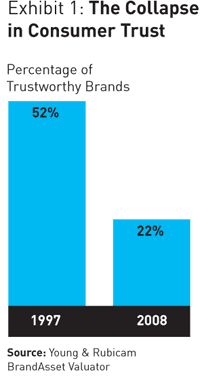 The final major problem with brands is loss of trust. Our data shows that the amount of trust consumers place in a brand today is a ghost of what it was 10 years ago. In 1997, more than half of all brands enjoyed high levels of consumer trust. But society’s faith in institutions, corporations, and leaders has been severely rocked by scandals and betrayals, from misconduct at our investment banks to salmonella in our peanut butter to human growth hormone in our baseball players. One by one, such revelations have battered corporate credibility, leaving few brands immune. By 2008, consumers voted just over one-fifth of brands as trustworthy, more than halving the number of trusted brands in just over one decade. (See Exhibit 1.)
The final major problem with brands is loss of trust. Our data shows that the amount of trust consumers place in a brand today is a ghost of what it was 10 years ago. In 1997, more than half of all brands enjoyed high levels of consumer trust. But society’s faith in institutions, corporations, and leaders has been severely rocked by scandals and betrayals, from misconduct at our investment banks to salmonella in our peanut butter to human growth hormone in our baseball players. One by one, such revelations have battered corporate credibility, leaving few brands immune. By 2008, consumers voted just over one-fifth of brands as trustworthy, more than halving the number of trusted brands in just over one decade. (See Exhibit 1.)
Where does this leave those of us who are responsible for marketing and managing brands? How can brands build sustainable long-term value to get back into alignment with Wall Street’s expectations and valuations? The answer is not found in simply redoubling efforts to win back consumer awareness, esteem, and respect. Too much has changed in the world to just return to the old methods of marketing and expect better results.
We contend that conventional marketing continues to operate in a time warp. Most marketers keep striving to build consumer perceptions that drive current sales only for today. They skip along happily, stressing reason over emotion and persuasion over inspiration, still believing that customers can be programmed to form lifelong relationships, and that brands can forever maintain their intangible elixir of attraction and cachet. This manner of marketing pays too much deference to the brand’s existing equities, a reflection of past accomplishments. A reliance on brand equity can create a false sense of security, as though past recognition can generate an endless stream of future profits. Using only historic brand data to plot a course in today’s dynamic market is like driving 90 miles an hour looking out the back window.
The Anatomy of Energized Differentiation
Through our studies, we began noticing that consumers were concentrating their passion, devotion, and purchasing power on an ever-smaller portfolio of brands. We then noticed a correlation between these successful brands and a set of interrelated consumer metrics, that all add up to a more exciting, dynamic, and creative experience — in short, reflecting the brand’s energy. Energy was linked in the data to three main factors. First was the vision the brand presents to consumers, often originating from the leadership, convictions, and reputation of the company behind the brand. Second was the invention consumers perceive in the brand, through product or service innovation, design, or content. Third was the dynamism consumers feel — how the brand creates a persona, emotion, advocacy, and evangelism among consumers through its marketing and other forms of conversations with them.
Brands that rank high on our energy metrics include Adidas, iPhone, Nike, and Microsoft. The data shows that energy is not a function of brand maturity: Many established brands have as much energy as younger, flashier ones. Both McDonald’s and Walmart, for example, are highly energized. Energy plays a particularly powerful role in commoditized industries where brands usually struggle to build attributes like loyalty. In the airline sector, for example, the highest-energy brands include Southwest, JetBlue, and Virgin Atlantic; those brands have evoked much greater loyalty among consumers than low-energy brands like British Airways and Delta.
As we analyzed 48 different brand attributes in our database to isolate the metrics that capture brand energy, we began to find explanations for the anomaly we had discovered, and a way for brand managers to succeed in today’s changed marketing environment. We now know, and we can demonstrate, that brand energy is what keeps brands constantly moving and that it is critical to maintaining ongoing consumer appeal, loyalty, and success. To show how this works, we need to give you some background on the methodology we use to measure brands. Our BrandAsset Valuator (BAV) — the empirical model we’ve built with our database of consumer survey information — has become well known in marketing venues and is cited in many marketing textbooks. Numerous major marketers rely on the validity of this research methodology and its powers of measurement and prediction.
The BAV is constructed with two categories of metrics. Brand stature captures what a brand has achieved up to the time of this survey. It incorporates such metrics as esteem (consumers’ perceptions of quality and loyalty) and knowledge (consumers’ awareness of and experience with the brand). This reflects the brand’s current position in the market and its current value, and is a lagging indicator: It tends to be affected after the brand has changed.
Brand strength measures the brand’s growth potential. It incorporates the brand’s relevance (consumers’ perceptions about how appropriate the brand is for them) and its differentiation (consumers’ perception of the brand’s unique meaning to them). Brand strength reflects the brand’s future value, and is a leading indicator: an early visible sign of change.
Once we identified the attributes and importance of brand energy, we found that it fit closely with differentiation, and thus combined them into the single metric of energized differentiation. The impact that energized differentiation has on relevance is extremely important. Without relevance, the brand will languish. The brand may stand out with energy but have no meaning to consumers. Relevance is the pathway to strong consideration, trial, preference, and ultimately share of wallet. This is especially important in today’s downward-spiraling market.
The unique measure of energized differentiation establishes a direct link between brand momentum and creativity, financial earnings, and stock performance. Brands that currently have energized differentiation in vast quantities include Amazon, Axe, Facebook, Innocent, IKEA, Land Rover, LG, Lego, Tata Nano, Twitter, Whole Foods, and Zappos. Given the importance of energized differentiation in determining overall Brand strength, it’s useful to look more closely at its subcomponents.
Differentiation not only represents the brand’s point of difference, it also creates the meaning, margin, and competitive advantage in the brand. Differentiation is made up of the way consumers perceive three brand attributes: the offering, or the measure of the brand’s special characteristics in terms of products, services, and other content that the consumer experiences; uniqueness, the brand’s essence, positioning, and brand equity; and distinction, the reputation the brand has earned through existing communications and brand image created up to this point.
But energy is where the action is. It reflects the consumer’s perception of motion and direction. It sustains the brand’s advantages. High-energy brands create a constant sense of interest and excitement. Consumers sense that these brands move faster, see farther, and are more experiential and more responsive to their needs. In our correlations, we see a definite pattern in energized brands: The more energy they have, the greater consideration, loyalty, pricing power, and brand value (as a percentage of firm value) they command.
The three attribute clusters that make up energy have all been associated with momentum and industry leadership. They are:
1. Vision. Brands with vision embody a clear direction and point of view on the world. They convey what they’re on this planet to achieve. Some brands promise to change the way people think; others seek to shift expectations about the way things are done. Vision-driven brands see farther; they galvanize and inspire consumers to join in, allowing the brand to travel into new categories and create new meaning.
A parent company’s reputation can play a significant role in driving brand vision: How does the company act and behave toward its consumers, its employees, or the world beyond commerce? Does the company have an inspiring reputation that consumers admire? Is the company a great place to work? Does it care about social issues? Does it have a unique and powerful culture? In a transparent society, consumers don’t divorce their perceptions of the brand from overarching company values and conduct. They expect visionary brands to stand for higher-order benefits — and that also goes for the company behind the brand.
Brands that score strongly on vision include General Electric, Walmart, and Toyota, which have led in their categories on energy savings; Southwest Airlines, which says “Employees are our first customers” — and means it; IKEA, named one of the world’s most ethical corporations in 2007 for its employee practices and its promotion of environmental issues and children’s welfare; and Subway, which invented a new category of quick-service restaurant, healthy fast food.
2. Invention. Brands that score high in invention change how people feel and the way they behave. As the most functional element of energy, invention is built on the tactile and sensory associations that come from product and service experiences and other physical brand interactions. Invention can be built through innovation, brand iconography, packaging design, applied technology, retail environments, and customer service. A brand’s invention can never be static. It requires a commitment to continuous innovation, service excellence, and new forms of brand experience.
The brands that possess demonstrably strong invention include W Hotels, which offers its guests Wi-Fi in the lobby, “fashion emergency kits” from Diane von Furstenberg, and products from Bliss Spa; Zappos, which excels at customer service, including free returns on shoes purchased over the Internet; Nike and Apple, which teamed up to create Nike+, where Nike shoes transfer workout data to an iPod Nano; and Kidfresh, which introduced nutritious fast food for children with playful presentation and packaging.
3. Dynamism. Brands with dynamism create excitement in the marketplace through the way they present themselves to consumers. Dynamism is the most emotional and immediately visible of the three components. It reflects the brand’s ability to inspire consumer affinity. Traditionally the outcome of a big ad campaign, guerrilla marketing event, or highly visible marketplace event, dynamism engenders a persona, community, and evangelism among a brand’s users. Dynamic brands penetrate popular culture. They give consumers something to talk about, facilitating enthusiastic word-of-mouth discussion across consumer social networks and brand ecosystems.
The brands with top scores in this category illustrate the many flavors of brand dynamism: Harley-Davidson, which holds a rally in Sturgis, S.D., each August that marks the largest concentration of motorcycles on the planet; Twitter, which took SMS messaging to a fluid form of social networking used by millions; Design Barcode in Tokyo, which patented its idea to turn ordinary barcodes on products into forms of visual communication; and Mini Cooper, which mailed owners RFID chips with customizable messages that flash up on Mini billboards when they pass by.
Putting the Metrics to Work
By plotting a brand’s scores for measures of both brand strength and brand stature, we can paint an accurate, holistic picture of its status as a forward-looking measure of performance. We accomplish this by charting a two-by-two matrix that plots strength against stature. This can be done for a single brand at a time or for as many as thousands of global brands, creating a sort of “brand constellation,” something that resembles a stargazer map showing where all brands are at any given moment in comparison to one another without regard to brand categories.
As Exhibit 2 shows, the BAV matrix uses performance to plot a brand into one of four quadrants, each of which is indicative of brands’ status in a very specific way.
When a brand generates abundant energy, it becomes more irresistible, which creates greater preference and usage, in turn attracting new users. We analyzed more than 2,000 brands in the BAV database over a four-year period and found that brands with higher energy-to-equity ratios in a given year showed substantial growth in usage and preference over the following year. One revealing exercise is to plot high-energy brands against their category averages and array them in the grid of stature and strength. These brands, thanks to energized differentiation, zoom upward out of their industries into much higher realms of performance. This exercise shows that they have become irresistible brands that transcend their categories and redefine their own markets. (See Exhibit 3.)
Energized brands like those shown in Exhibit 3 become market leaders that set new expectations for the way things should be. They don’t aim for mere awareness. Instead, they upend ideologies, challenge convention, and market themselves to consumers’ value systems. They tap into mind-sets that find business in a broader cross-section of the marketplace, attracting new users and growing their categories. And they go where the money is, creating greater margin power and future value creation. Companies with energized brands also deliver superior returns for shareholders over time. (See Exhibit 4.)
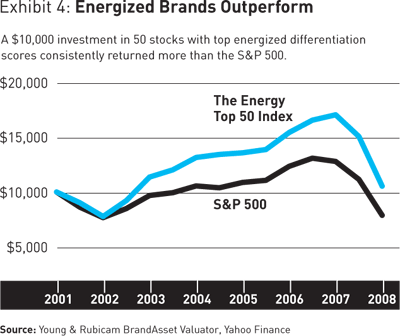
Building the Energy-driven Enterprise
We now know that the brands that are thriving even in today’s difficult markets, and that will succeed in the future, have a more powerful form of differentiation than other brands — one with energy. These brands offer consumers a palpable sense of movement. Brands with energized differentiation drive future corporate financial performance more than the traditional brands that dominated the market for decades.
There’s an old adage, “Something that’s truly innovative can’t be measured.” But we’re now able to demonstrate the economic value of creativity in brands and explain how brands can break out to affect the future financial performance of their firms. We can link brand momentum and creativity with predictive financial performance.
The results suggest that there is a comprehensive five-step framework for companies that wish to build an irresistible brand by infusing it with energy.
1. Perform an “energy audit” on your brand. Your goal is to capture a baseline that identifies the current sources and level of energy so you can understand your brand’s strengths and weaknesses and detect how well your brand management is aligned with the dynamics of the new marketplace. As an entry point to the energy audit, we invite you to draw upon our proprietary BAV database.
2. Make your brand an organizing principle for the business. Do this by finding an essential brand thought that everyone can buy into. We call this process “building the energy core” — and it should be a lens through which every aspect of the customer experience, including products, services, and communications, is defined. A strong core allows a brand to segment customers by attitude and values, reorganizing its products and services with regard to customer insights and deeper emotional needs. A powerful core aligns the organization and allows it to more aggressively shape its future.
3. Create an energized value chain. The organization’s goals for the brand must become real for everyone; all participants must understand how their own actions boost the energy level of the brand and fuel the core. This process needs to begin in the C-suite and extend to all functional areas — sales, manufacturing and operations, distribution, information technology, customer relationship management, and human resources.
4. Become an energy-driven enterprise. Management must next focus on formalizing this way of working throughout the organization. Stakeholders need to transfer their energy and passion to their business units and functions. Once management’s aspirations for the brand and business become part of the culture, the process of building an energized brand enterprise is propelled forward.
5. Create a loop of constant reinvention. The final stage is to make sure that the organization and its brand are in a state of constant renewal. Brand managers must be ready to reshape themselves over and over again. Brands, like business, are in permanent flux. We must listen carefully to the market, and continuously modify, personalize, share, and improve upon our offerings. Especially in today’s economic environment, the benefits consumers are looking for in brands are evolving. By being keenly aware of these shifts in consumers’ perception and values, marketers can help their brands survive — and even grow into irresistible ones.![]()
Reprint No. 09205
Author profiles:
- John Gerzema is chief insights officer at Young & Rubicam and previously ran Fallon’s international network. He has guided brand strategies for many global businesses, including Coca-Cola, McDonald’s, Microsoft, SABMiller, Nikon, and Sony.
- Ed Lebar is chief executive officer of BrandAsset Consulting and oversees brand strategy and research for Young & Rubicam. He is a former professor of economics at the City College of New York and Finch College.
- This article was adapted from The Brand Bubble: The Looming Crisis in Brand Value and How to Avoid It, by John Gerzema and Ed Lebar (Jossey-Bass, 2008).


